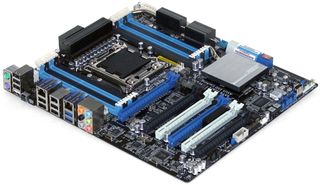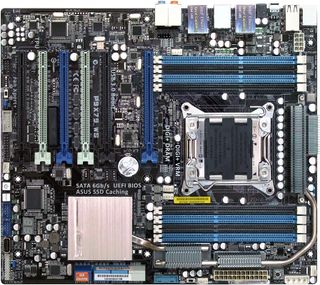Ultimate X79? Five $320+ LGA 2011 Motherboards, Reviewed
Our flagship motherboard comparison announcement was answered with an interesting selection of models, along with a bunch of “not ready yet” responses. Today we examine a few samples from companies bold enough to step up to the plate during launch week.
Asus P9X79 WS
Though the WS moniker implies a workstation target market, many of these boards have become preferred solutions for gamers and traditional power users. The P9X79 WS follows that tradition by facilitating six PCIe x16 slots, keeping the Deluxe model's Intel gigabit network PHY, and upgrading its second gigabit Ethernet controller from Realtek to an Intel PCIe model.

Even more traditional are two PS/2 ports and the lack of Asus' Deluxe model’s Bluetooth/Wi-Fi module. The WS also loses four of the Deluxe’s USB 3.0 rear-panel and four of its front-panel USB 2.0 ports favor of traditional FireWire and serial connectors. WS users do get one of those USB 2.0 ports back, however, in the form of an external port mounted internally for use with thumb drives. Did someone say ReadyBoost?
The P9X79 WS keeps the Deluxe version’s USB BIOS Flashback feature, along with its MemOK button and TPU/EPU switches. MemOK automatically underclocks RAM to help get through the boot process with poorly programmed modules, TPU enables Asus’ pre-defined automatic overclock settings, and EPU enables Asus’ power-saving CPU voltage reduction routine.

The P9X79 WS is specifically designed for four-way SLI, switching its blue x16 slots to x8 mode whenever its black x16 slots are filled. The included three-way SLI bridge is spaced for x8-x8-x16 transfers, and the grey slots each use four of the LGA 2011 package’s eight remaining PCIe lanes.
The P9X79 WS moves its front-panel audio connector several inches northward from it expected location, where it rests slightly forward of the rear audio jacks. While that does sound like a break from tradition, this placement makes it far easier to use with Thermaltake’s older cases (which had notoriously short front-panel cables).
Our only layout concern is that an upward-facing latch on the eight-pin CPU power connector could be difficult to reach when this board is installed with its cable wrapped over the top of a motherboard tray.

Two, three, and four-way SLI bridges are included in the P9X79 WS installation kit, along with eight SATA cables and even a serial port breakout plate. The mix of old and new might make this the perfect board for elder geeks, but we’ve yet to see how it performs!
Stay on the Cutting Edge
Join the experts who read Tom's Hardware for the inside track on enthusiast PC tech news — and have for over 25 years. We'll send breaking news and in-depth reviews of CPUs, GPUs, AI, maker hardware and more straight to your inbox.
-
lradunovic77 Something is wrong with your ASRock Extreme 9 testing. You article states that you used BIOS 1.40 however first release for this Motherboard was 1.60 and they also recently released 1.70. Bios 1.40 is for ASRock Extreme 4 which i own as well. Again in mean time they updated BIOS for ASRock Extreme 4 to version 1.50 which greatly improves overclocking. I have C1 and i am hitting 4.4Ghz easily. (1.50 BIOS ASRock Extreme 4).Reply
You might want re check the facts.
Thanks. -
Crashman lradunovic77Something is wrong ...You might want re check the facts.Please do verify the facts beginning with the first X79 Extreme9 UEFI screenshot on page 3, showing version P 1.40 . The latest public firmware was downloaded for every motherboard on November 18, which is before ASRock says its P1.60 was even published. And, if you check Newegg, you'll find that Newegg was actually selling the X79 Extreme9 before firmware P1.60 was published.Reply
How could that happen? ASRock has repeatedly removed previous BIOS versions from its website and labeled the replacement as the initial release.
This review was published after many hours of collaboration with ASRock, and some of the problems with this specific CPU are further detailed in the overclocking section. ASRock acknowledged the problem exists with a portion of the C1 CPU supply and has begun issuing patched BIOS to fix the multiplier issue, according to ASRock engineer William Yu. -
oxxfatelostxxo ReplyI have C1 and i am hitting 4.4Ghz easily. (1.50 BIOS ASRock Extreme 4).
Not to mention that they didnt say they couldnt hit 4.4ghz, they just stated they didnt get that high without going beyond 1.35v
Kinda wish we got to see a MAX overclock for air before temps got out of control =P
But then you get various coolers involved... yada yada... but PLEASE anyway -
clonazepam This was a fun article to read. I wanted to quote a few bits here and there just to point out I enjoyed the humor in it, but that would have been a lot of quotes. It's subtle, tasteful way to add personality to the piece.Reply
I had to comment on something. I can't really comment on the hardware as its so enthusiast and SB-E is well beyond my needs. I can't comment too much on the bios because I still barely understand mine, but I am seeing the trend that it might be best to stick with what you know, or risk having to translate the various names/definitions of settings across different products. I'm not that smart nor that patient. I liked the comment on the 6.00...lol... %! I never would have thought. I think that just deciphered half of my bios options, thanks. /wink -
In the comparison table on the ASUS : "6 (x16/x0/x4/x16/x4/x0 or x8/x8/x4/x8/x84/x8)" -- x84 seems somewhat unlikely ;-)Reply
-
gmcizzle Not surprised both Asus boards came out on top performance wise, on most of these mobo roundups they usually do.Reply -
Steveymoo Without trying to sound critical, wouldn't it be prudent to test SLI scaling on these enthusiast boards? 1, 2, and 3 way SLI, extra PCI-E bandwidth is one of the main reason why people even bother splashing out the extra cash on these chipsets. (Aside from the extra epeen++)Reply
Just sayin' -
Crashman shstoneIn the comparison table on the ASUS : "6 (x16/x0/x4/x16/x4/x0 or x8/x8/x4/x8/x84/x8)" -- x84 seems somewhat unlikely ;-)Thanks. Yes, the x4 stays the same. Fixed!SteveymooWithout trying to sound critical, wouldn't it be prudent to test SLI scaling on these enthusiast boards? 1, 2, and 3 way SLI, extra PCI-E bandwidth is one of the main reason why people even bother splashing out the extra cash on these chipsets. (Aside from the extra epeen++)Just sayin'You obviously don't understand the value of those +++'s!Reply -
AstroTC AsRock has the better looking MB by far...Reply
Question does tht little fan on the motherboard get loud? If it does that would be a deal breaker for me -
CaedenV the problem with testing mobos is that they all have the same core (in this case the x79) which is what determines the raw speed of the system and busses, so they are all pretty well bunched together with no possibility of seeing any real world difference between boards. The things that differentiate the boards is in their feature sets, and as they are all rather different there is no proper way to test them against one another. Add to that the fact that these are all brand new boards which will see improvements with new UEFI releases, and there is really no way to pick a clear winner.Reply
On a side note I would love to see how these boards look assembled :)
Most Popular


